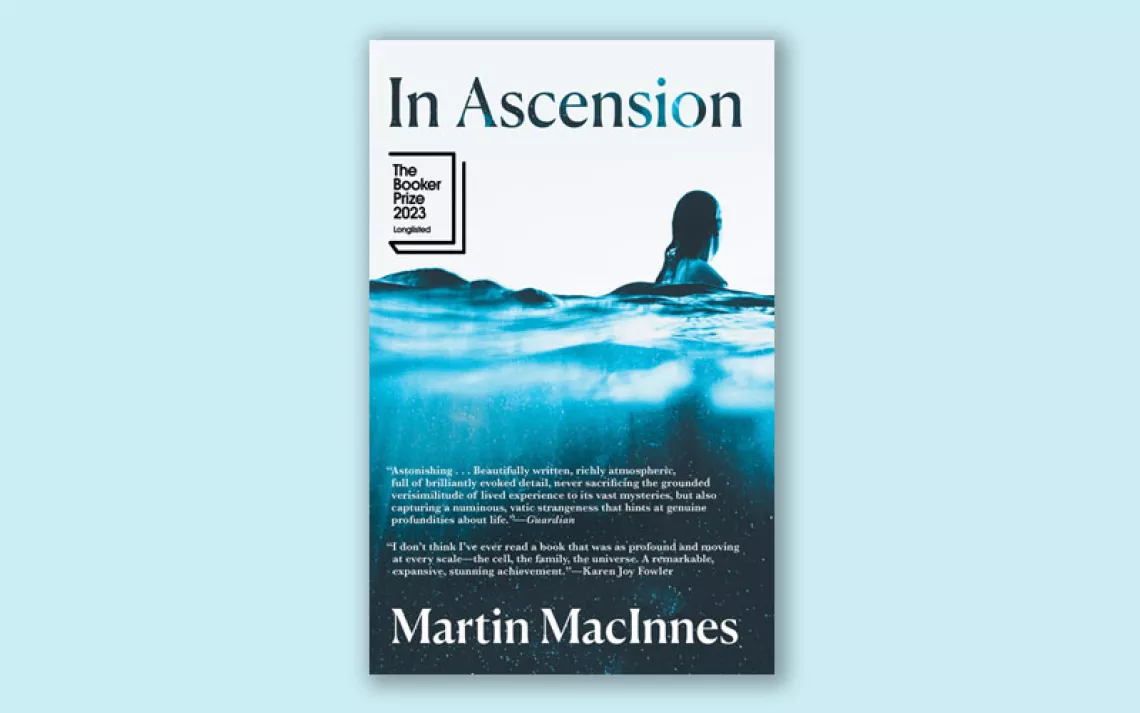The Flood That Sparked a Latino Environmental Justice Movement
An excerpt from the new book "West Side Rising"
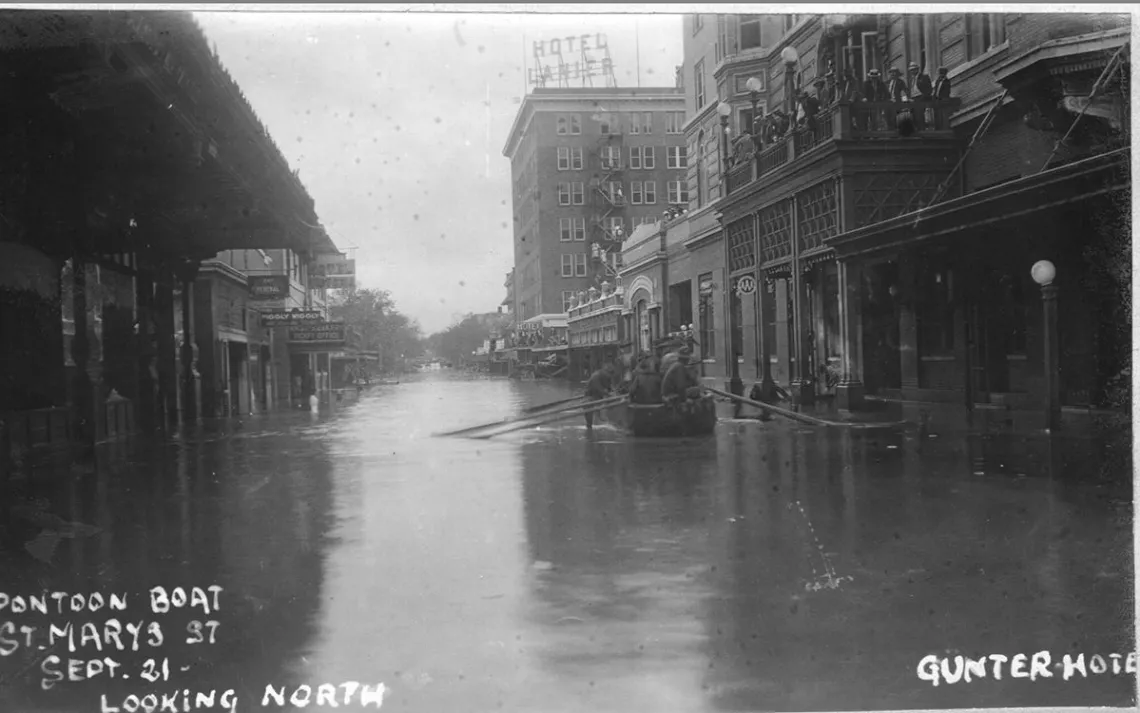
Photos courtesy of Trinity University Press
Excerpted from the new book "West Side Rising: How San Antonio's 1921 Flood Devastated a City and Sparked a Latino Environmental Justice Movement" by Char Miller. Copyright (c) 2021 by Char Miller. Used with permission of the publisher, Trinity University Press. All rights reserved.
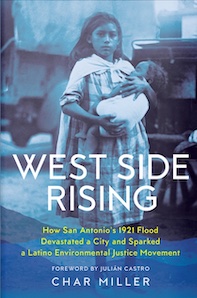 Chapter Six: Uprising
Chapter Six: Uprising
Zarzamora Creek is an eight-mile dusty channel that falls away from the low hills, that delineate the northwestern rim of San Antonio. The creek first twists and turns in a southwesterly direction, then breaks south and east before flowing into a retention pond known as Elmendorf Lake, merging there with Apache Creek. Their combined stream flow then pushes southeast and joins with the Alazán before the final confluence with the San Pedro; a mile or so later, the flow of these four creeks merges with the San Antonio River. The Zarzamora is thus a small, almost invisible part of the San Antonio River’s 4,180-square-mile drainage system.
Yet the Zarzamora has had a nasty habit of becoming quite noticeable when it rains. Like the other West Side creeks, its flow increases quickly as rainwater cascades down the slopes and ravines that serve as its tributaries; it rises fast within its narrow confines, accelerating rapidly, so that should it leap out of its banks it will ram into the built landscape with considerable power.
One such flood forced the little-noticed Zarzamora Creek into public consciousness. On August 8, 1974, a torrential downburst erupted over San Antonio causing the creek to immediately roar to life. It swamped the streets of the low-lying neighborhoods slotted along its course, forcing dozens of families from their homes and taking out a bridge. Once the fetid waters finally receded, they left behind a tangled mass of debris from tree limbs to shopping carts. While such damage was normal on the West Side barrio over the decades, this was no longer being accepted.
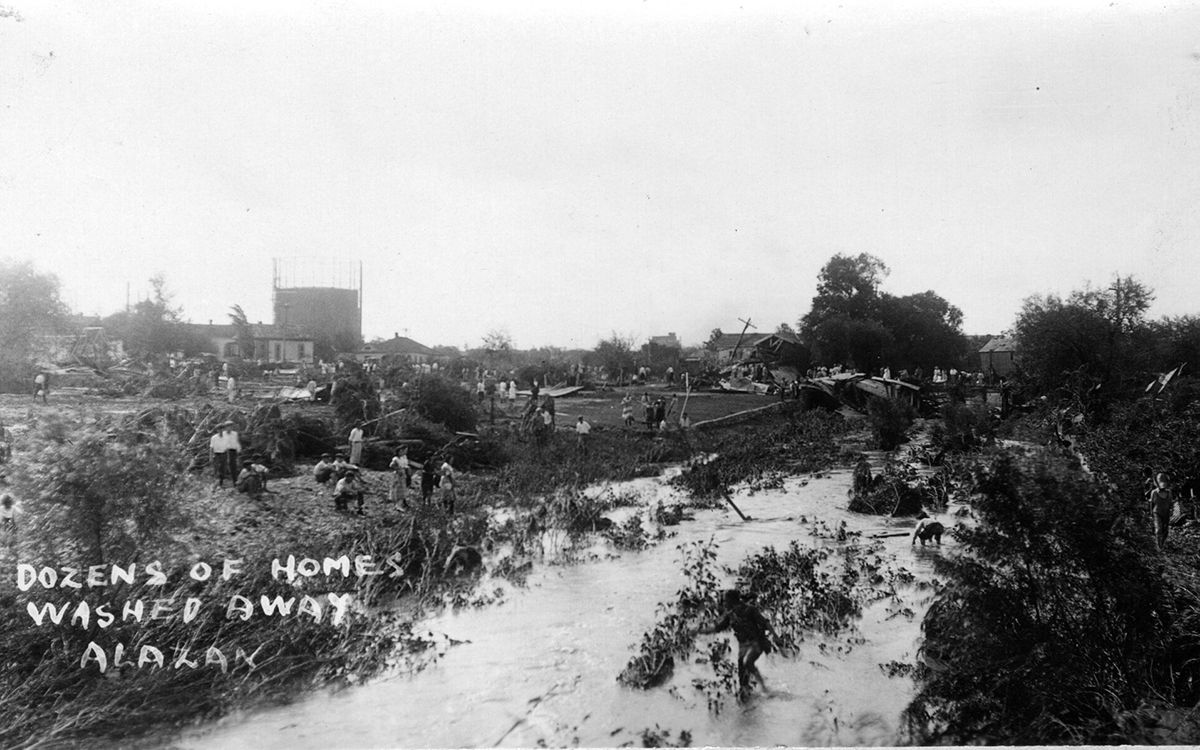
The flood provoked a public outcry that could not be contained within the narrow confines that had long defined San Antonio’s segregated civic arena. Making use of this storm was a handful of grassroots activists. Over the previous year, and under the banner of Communities Organized for Public Services (COPS), they had been quietly organizing among community activists, union organizers, and Catholic parishes on the city’s West Side. Ernie Cortés, who had trained at the Saul Alinsky–founded Industrial Areas Foundation, was its initial galvanizing presence. He met face-to-face with over one thousand allies, learning that West Siders believed the twinned issues of drainage and flood control were of paramount importance. So when the 1974 flood raced through the community, its residents turned its damaging impact to their benefit, building momentum for a well-planned assault on discriminatory public policies that routinely forced the poor, disadvantaged, and under-resourced to scramble for higher ground, climb onto a roof or cling to the nearest tree every time floodwaters rampaged through their neighborhoods.
Wielding what we now refer to as the language of environmental justice, these protestors challenged the social inequities they endured, the political discrimination from which they suffered, and the disproportionate burdens they bore, and did so through an intense process of self-education that revealed the political context of the physical world they inhabited. This in turn allowed them to identify the means they could employ to better protect their lives and livelihoods, make their community less flood-prone and more habitable, and, along the way, wrest power from a white elite whose privilege rarely had been contested.
COPS’s grassroots protests in the early 1970s over the inequities of flooding in San Antonio drew on the heritage of Latino political activism that had emerged before World War II and intensified thereafter, the new organization’s potent challenge to the city’s willful neglect of low-lying, poor neighborhoods gave voice to the Latino citizenry and morphed into a full-scale assault on an array of related environmental, social, and public health issues that culminated in the rewriting of the city's governing charter. San Antonio politics were altered significantly, and as a result COPS's organizing tactics spread to other urban centers with large Latino populations; the organization’s energetic activism helped change the political dynamics of the US Southwest.
Yet COPS had older antecedents. One of the earliest was Cruz Azul Mexicana (Blue Cross), a West Side mutual aid society. Like COPS, it drew its members from the local Mexican American population. Like COPS, its membership—leaders and led—was predominantly women. Like COPS, it brought to bear local knowledge, expertise, heritage, and culture to define its activism. Most tellingly, like COPS, it found its feet in and proved its worth during a flood, in this case the disastrous flood of 1921.
The flood had begun on the evening of Friday, September 9, with heavy rain lashing the upper watersheds of the city’s West Side creeks and the San Antonio River. By 10 P.M., the creeks were rampaging through the shack-filled streets of the impoverished West Side and Saint Mary’s Street, a major north-south thoroughfare through the downtown district had become a river. At least 80 people died, nearly all of whom lived on the West Side and were Spanish-surnamed. This disparity in the demographics and distribution of death in San Antonio dovetails with a statewide pattern with regard to the disaster: spatial inequities, ethnic discrimination, and environmental injustices determined who survived and who died in this massive flood. Since the 1850s, the West Side had housed the city’s poorest residents, who lived in substandard housing and experienced frequent outbreaks of tuberculosis, yellow fever, and other diseases. It was not an accident, then, that the September 1921 flood was especially lethal and catastrophic for those who were geographically marginalized.
The number of fatalities would have been greater had not members of Cruz Azul Mexicana (Blue Cross of Mexico) and other West Side mutual-aid societies joined police, firefighters, and US Army troops in pulling people from the turbulent waters. In advance of the Red Cross, homegrown and hands-on Cruz Azul had set up two relief stations that provided food, clothing, and emotional support. They maintained its relief stations well into November, a persistence that earned the organization praise from the local chapter of the Red Cross and the city’s public officials.
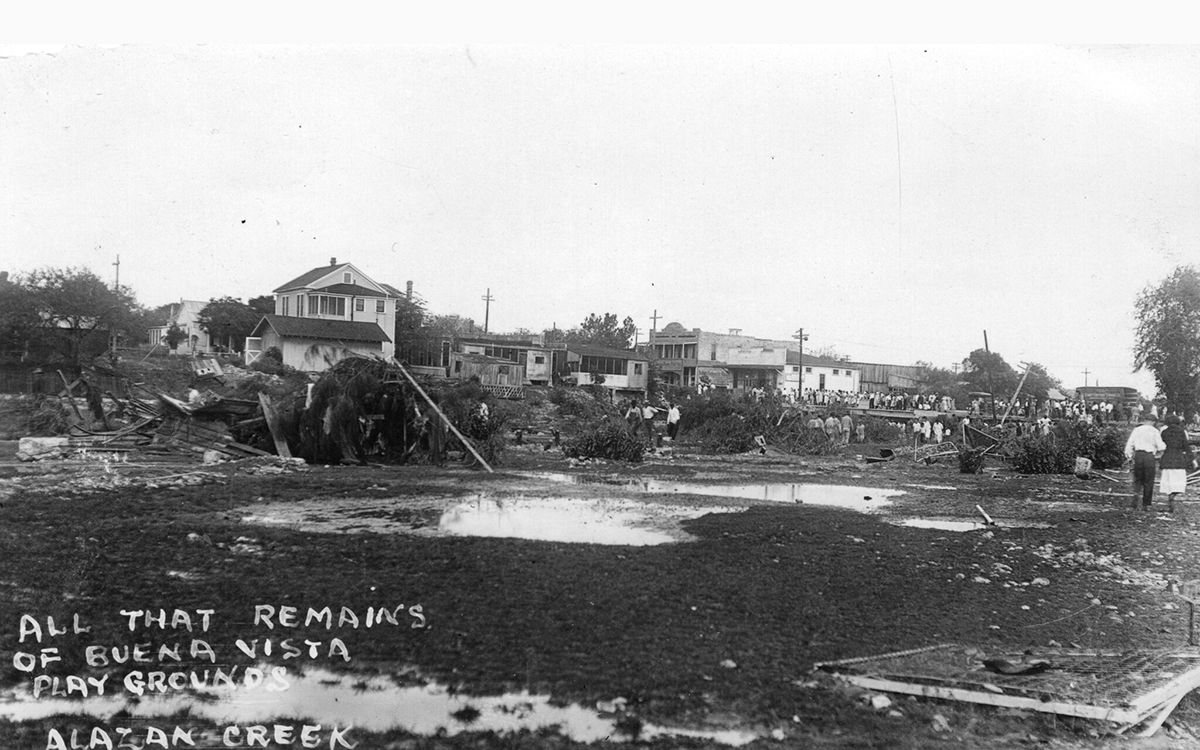
The city’s commissioners meanwhile focused their attention and local tax dollars on their interests by forming a flood prevention committee, which consisted of major downtown property owners. The group developed a political consensus around the pressing need for a dam and other related flood control infrastructure to protect the business district’s property values and boost the urban economy—public money buttressed private capital. “San Antonio was run by a fairly well-knit oligarchy of very well-off people,” said Cortés in an interview. “All of whom mostly whites and WASPs, lived in the northeast quadrant of the city and kind of dominated the politics and economics of the city.”
With the completion of the Olmos Dam in late 1926 to its north and a straightened, deeper, and wider river running south, San Antonio’s downtown boomed. Major skyscrapers soared above the streets, new municipal facilities, bridges, and other infrastructure were constructed. By the 1930s, the fabled Riverwalk—now a significant tourist attraction—began to take shape. Yet the West Side was largely overlooked. True, the major river confluences appear to have been restructured to carry greater volumes of water, and some of the creek beds would be cleared of vegetation. None of these improvements, though, offered the kind of economic stimulus that elsewhere increased the property values and assets of the city’s downtown merchants and landlords.
*
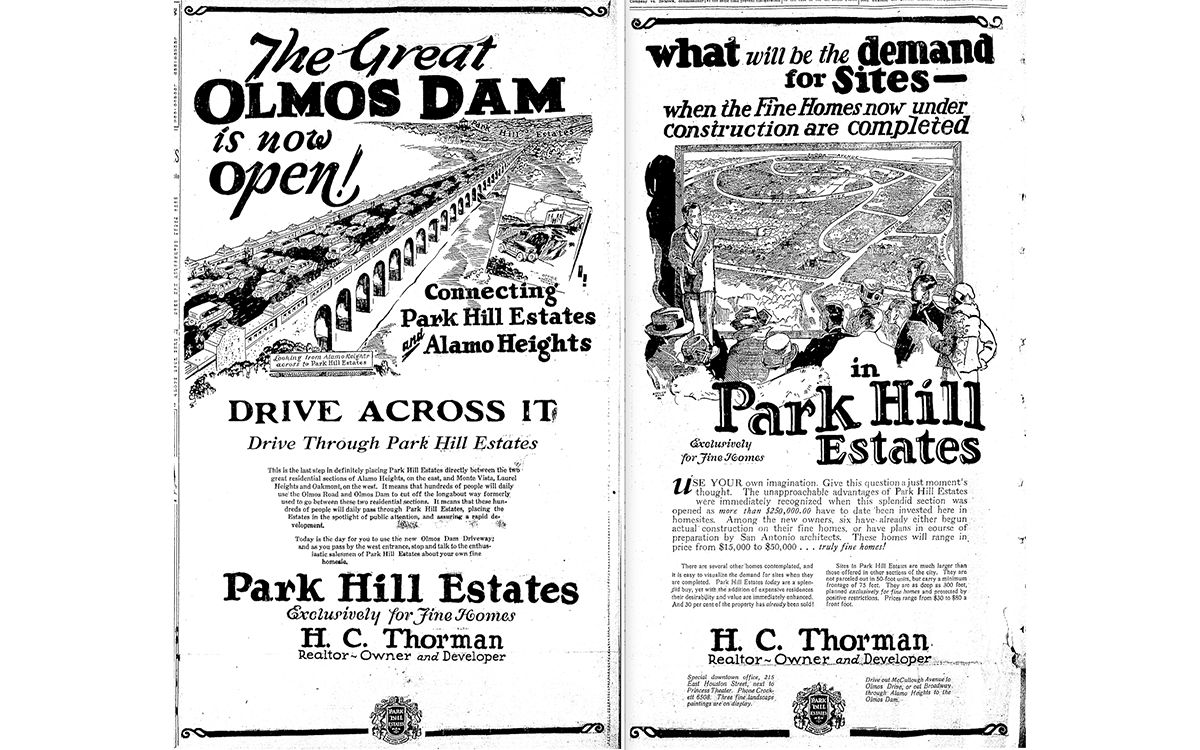
Tempered by this crisis, in the succeeding decade, Cruz Azul interceded with civic, state, federal authorities to protect West Side residents from the xenophobia that built across the 1920s and buffered from the federal government’s deportation orders. Whatever their success, these actions designed to cushion the worst impacts of the federal government’s anti-immigration policies testifies to the growing sense of solidarity and agency among San Antonio mutualistas like Cruz Azula and more broadly within the community they served. After New Deal programs in the 1930s began to offset the need for mutual aid groups, Cruz Azul began to fade. But eventually, a new generation of West Side politicians and organizers began stepping forward, taking advantage of new civil rights laws and expanded federal influence in urban life.
Rep. Henry B. González, a son of the West Side, knew well the grinding realities of this flood-prone section of the city when he was elected in 1960 as an insurgent candidate. He was the first Hispanic politician to represent Texas in Congress, where he served for 37 years. No sooner had Henry B., as he was known locally, arrived in the nation’s capital than he began to build political support for federal dollars to pull his constituents out of danger. He used another damaging flood, this one in 1965, to cast a very bright light on West Side flooding that local politicians had long kept shrouded. At his request, a high-powered delegation of congressional leaders visited the city to inspect the flood damage and hold a series of public hearings to hold the city and county accountable for its longstanding disregard. González’s colleagues then signed off on a significant federal outlay to channelize the West Side creeks, an investment that the city had pledged to do after the 1921 flood but never did.
For the next three decades, his political skill and community commitments, his marked ability to leverage federal funding streams for his district, changed one set of dynamics that had governed flood-control politics in San Antonio. With money came power, with power came the authority to determine where the money would be spent. By doing so, he forced those who for years had neglected his community to invest their time, energy, and capital resolving one of its most hazardous features.
COPS emerged as a new political force emerged in the fetid aftermath of the 1974 flood, armed with a new set of tactics to contest the city’s power elite. COPS derived much of its strength from its door-to-door grassroots activism; it was a bottom-up organization, whereas González worked from the top down. They were outside, and he was inside, although González would have disputed that too-easy analysis. “Given that the power to influence decisions that affect our lives is concentrated in the established systems of our government, I felt that I could contribute by participating in that process,” he once wrote. “There is a place for those who remain outside these processes, but I felt that I could contribute by influencing policy from the inside. Yet even on the inside, I have largely remained an outsider because of my refusal to surrender my independence.” What González and COPS shared was their conviction that politics was the lifeblood of democracy; everything—not least flooding and flood control—was political.
That insight is what drove COPS’s approach to drainage issues. It knew that those residing within the web of West Side creeks had waited patiently for lifesaving flood-control infrastructures. Tired of suffering from this form of slow violence and the political disregard that led to it, COPS activists challenged the city to finally act on behalf of flood-weary neighborhoods.
Start with the direct clash of wills that erupted on August 13, 1974, at the first public meeting between COPS and Sam Granata, the city manager. Mere days earlier, Zarzamora Creek had rushed out of its earthen embankment, yet another wet slap in the face of those too-long threatened with flooding, an event that infused the 500 COPS members who gathered at Kennedy High School with a renewed sense of outrage; it even “bolstered our faith in God,” one organizer later laughed.
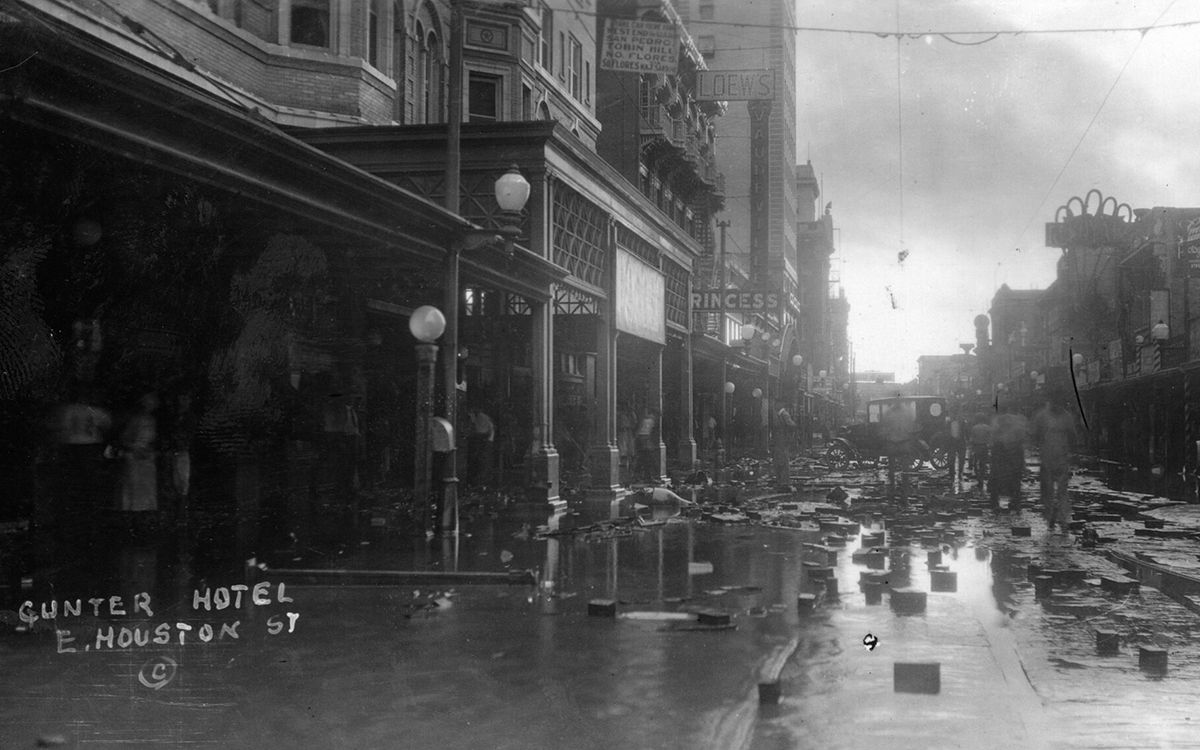
No one was amused at the time, though, as an unsuspecting Granata discovered when he walked into the school’s auditorium. An irate audience “demanded action on drainage improvements in the neighborhoods. They told the city manager they were not interested in long-winded explanations; he could keep his responses to ‘simple yes or no answers.’” To bolster their case, they screened photographic images of the longstanding pattern of neighborhood flooding and the havoc it routinely caused. “Scenes like these have been there for years and are still the same,” activist Ray Kaiser told Granata. “We have decided to not take it anymore. We have decided to make our problem, your problem.” When a flustered Granata confessed he did not have the authority to resolve their concerns—“To give a ‘yes’ and not be able to deliver would be a fraud. I can’t do it”—the rambunctious crowd asked him who had the authority. Told that city council was the appropriate body, COPS immediately asked him to place COPS’s demands on the following week’s agenda.
What happened at that council session has taken on a legendary cast. Hundreds of COPS supporters jammed city council chambers well beyond capacity, and, a reporter recounted, the crowd “broke all the time-honored rules about how citizens are supposed to address the council on a sign-in basis, one at a time.” With a theatrical sense of its emerging clout, the audience rose as one when its chief spokeswoman, Mrs. Héctor Alemán, walked to the podium microphone and crowded around her as she hammered the council into stunned submission. Telling the representatives that her West Side neighborhood lay within the Zarzamora’s floodplain, she related how every time thunder crackled overhead and rain fell, houses, streets, the local park, even the parish church went under water. Her voice cracked: “How would you feel getting out of bed in the morning and stepping into a river right in your house?” As with the other speakers, she made blunt political claim on the political process: “We are here to demand action. We don’t want excuses.” Her supporters roared.
Mrs. Alemán’s personal pitch came with a sharp edge. COPS researchers had burrowed deep into the city’s archives to locate the 1945 master plan, which contained provisions to reconstruct the Zarzamora as it swung past Mayberry Street, site of many of the bank-busting floods to which Alemán had alluded and close to her still-sodden home. Bond monies had been committed at that time but never spent. Charles Becker, who had been recently elected mayor, swiveled to ask Granata if Alemán’s account was accurate. Told that it was, he queried: “You mean to tell me this project has been on the city’s list that long and never received a thin dime?” Yes, Granata said. “Well, that’s a damn shame,” Becker replied: “How many people does this affect?” When advised that the number was more than 40,000, the shocked mayor gave city staff four hours to locate the financing for the Mayberry Street project, and then commanded council and COPS to return later that evening to learn the results. The staff complied; flood control was suddenly and emphatically on the city’s agenda.
The raucous public meeting and the flood that had precipitated it offered a resounding answer to cultural critic Rob Nixon’s potent query about environmental-justice activism: “How can we turn the long emergencies of slow violence into stories dramatic enough to rouse public sentiment and warrant political intervention?” COPS and its allies drew on their sophisticated conception of a streetscape environmentalism to power their electrifying campaign to change the conditions of life on the West Side. In this, COPS proved relentless. Within three months, it had cajoled the city council into calling a special bond election that would fund 15 westside drainage projects to the tune of $46.8 million; the measure passed easily. Over the next three years, COPS would reorient how city council and staff crafted the city’s budget, demanding and receiving commitments to underwrite $100 million for neighborhood improvements that ranged from flood control and street repair to trash pickup and water-and-sewer infrastructure. Within a decade, its organizing efforts had netted an estimated $500 million for local environmental and public health projects. COPS also compelled the city and SARA to apply for funding from the U.S. Department of Housing and Urban Development to build the new channels, dams, and culverts that began to dry out the often-soggy West Side.
COPS understood the broader implication of its demands for a more habitable landscape—to secure this goal required a shift in the city’s power dynamics. To do so, it helped launch similar organizations on the largely African American East Side and on the ethnically mixed South Side, a pattern of collaborative, citywide activism that was unprecedented in San Antonio. Within a year of the 1974 city council meeting, COPS had also formed an alliance with North Side (and mostly Anglo) environmentalists to battle against a massive housing development over the recharge zone of the Edwards Aquifer, successfully protecting the city’s sole source of drinking water. That COPS helped build a broad-based, multi-ethnic, cross-sector alliance was also crucial to its success and its ability to sow hope.
These achievements had ramifications for local politics, making San Antonio a more democratic place, a transformative effect that gained even greater force as some COPS members joined with the Mexican American Legal Defense and Educational Fund to force the rewriting of the city’s charter. For the preceding 20 years, that governing document had mandated that city council elections be run on an at-large basis. This form of governance had enabled the Good Government League, a North Side political machine, to dominate the local political arena. Its dominance was reflected in its distribution of the public dollars—it freely spent tax monies to underwrite the expanding suburbs its supporters resided within and the central business district in which they worked. The US Department of Justice (DOJ) entered the fray after charter-revision forces sued the city in federal court, arguing that the at-large political structure violated provisions of the Voting Rights Act of 1964–65. The DOJ compelled the city to submit a revised charter to the voters in January 1977 that created 10 city-council districts, and the plan was narrowly approved with 52 percent of the vote.
Get-out-the-vote campaigns on the West Side were critical to the new charter’s passage; its precincts reported nearly 90 percent in support of a new, more equitable government. Four years later, this newly empowered West Side electorate made one of its own, Henry Cisneros, mayor of San Antonio; on the campaign trail he had given voice to its residents’ plight and prospects: “Over the last decade, generations of Mejicanos have worked their fingers and shoulders raw and driven themselves to premature old age in order that their sons and daughters could take their rightful places in society,” the 33-year-old Cisneros thundered. “That legacy of sweat and tears provides a moral imperative that this generation assert itself to fulfill its most sacred dreams. . . . We have a generation of men and women who are hungry for what they can achieve as only those who have been barred from the table can be hungry.”
*
At its 10th-anniversary celebrations, COPS’s first president, Andy Sarabia, reminded his audience of what they once had confronted: “Ten years ago, city leaders said, ‘Leave them alone. They’re Mexicans. They can’t organize.’ Today, we have power, we have our culture, we have our faith, we have our communities, we have our dignity, and we’re still Mexicans. They feared the successful revolution from a government of the few by the few to a government of the people by the people and for the people. The significance is that the powerless do not have to stay powerless.”
To secure power, COPS’s members first had to place themselves on the map, to recognize that the historic and ongoing flooding of the Zarzamora and other West Side creeks was a consequence of nature and politics, of the physical and the political landscape they inhabited. Only then could they identify the need for a social response to this occasionally deadly environmental force. To achieve that level of identification required in turn that they understand their marginal location within local politics, develop a new framework by which to articulate their community’s newfound identity, fight to insert themselves into the center of the civic arena, and, once there, use their authority to transform the physical terrain they called home. This process, at once transformative and reciprocal, legitimized their mobilization around a streetscape environmentalism that made it possible for them to imagine a future that was more just and sustainable—and a good deal less treacherous. Nature, the source of so much death, damage, and disarray on San Antonio’s West Side, had become the catalyst of its residents’ liberation, a liberation that was itself a long-delayed redemption of those who had been swept away in the 1921 flood.
 The Magazine of The Sierra Club
The Magazine of The Sierra Club

